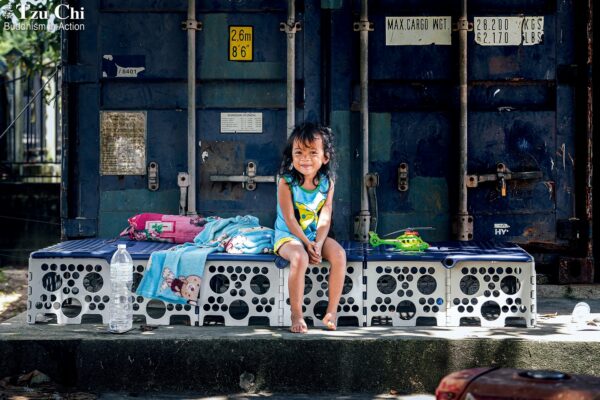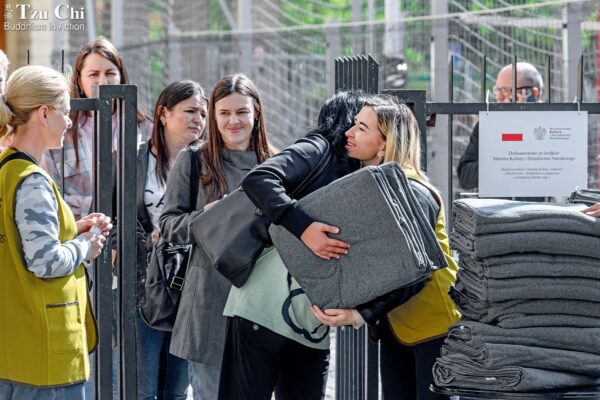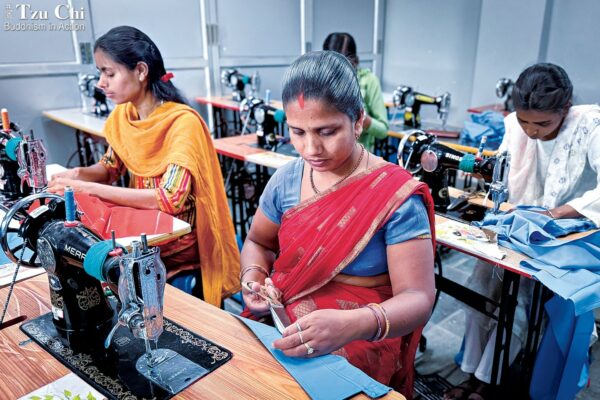By Chen Li-an
Compiled and translated by Wu Hsiao-ting
Photos by Huang Xiao-zhe
To farmers in Laos used to a quiet rural life, the large, impressive Tzu Chi distributions were a novelty. After the farmers had lost their crops to devastating floods, they received rice seeds and other aid from a group of strangers who bowed to them as they politely handed over the goods. In the process, the farmers glimpsed a world very different from theirs.
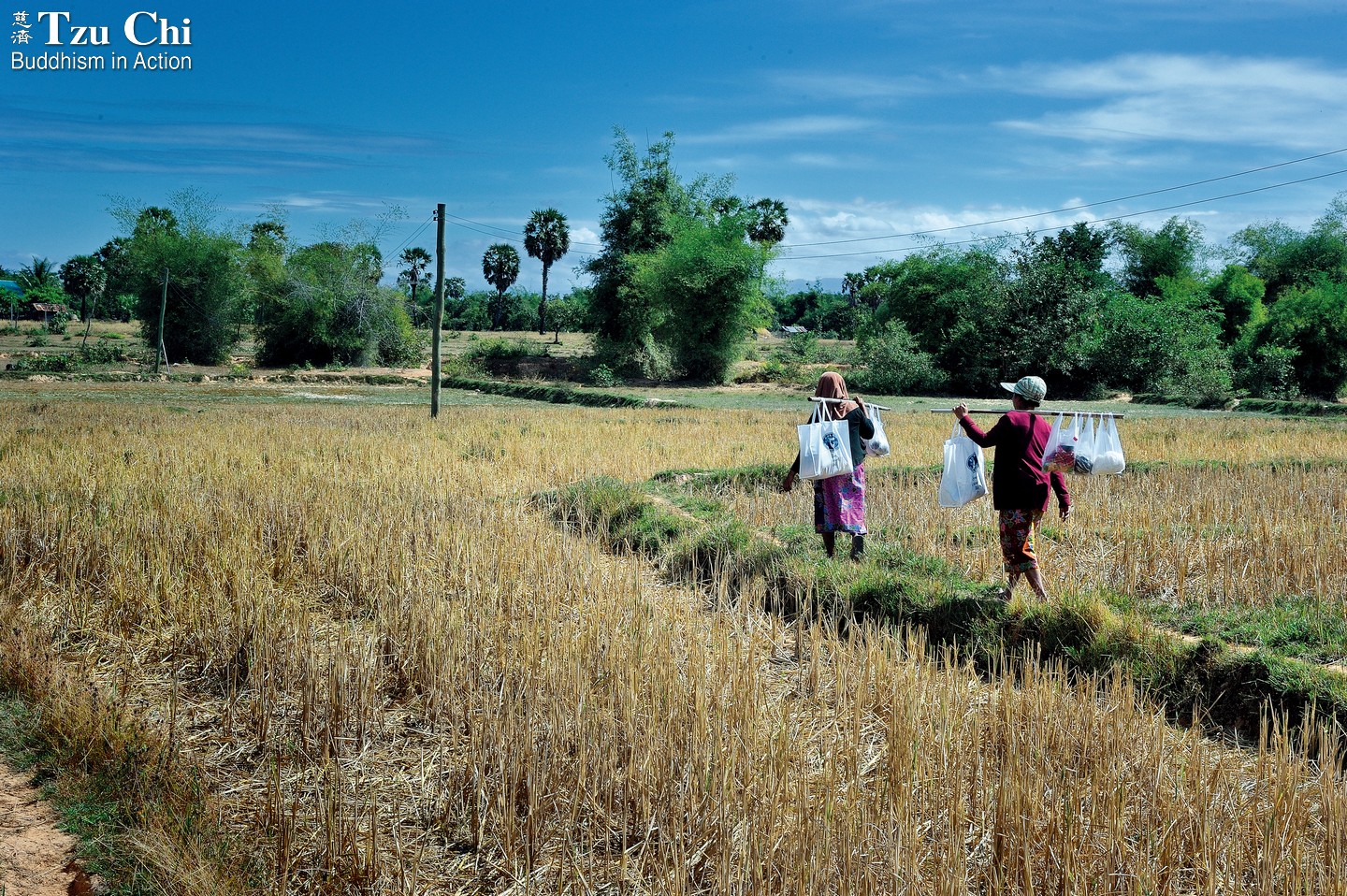
Flood victims, carrying relief items distributed by Tzu Chi on shoulder poles, return home through fields of dry rice stalks.


The River of Bounty—the Mekong
The Mekong River flows through China, Laos, Myanmar, Thailand, Cambodia, and Vietnam, providing an important source of water. Of these nations, Laos is located almost entirely within the lower Mekong basin. The river has, as a result, greatly nurtured the country’s agriculture. In recent years, Laos has invested copiously in hydroelectric power. There are nearly one hundred finished and ongoing dam construction projects in the nation. Most of the hydropower generated is exported to neighboring countries.
In August and September 2019, heavy rains pummeled Laos and caused the Mekong to burst its banks. More than 151,000 hectares (373,130 acres) of farmland in southern Laos were submerged in water. Farmers endured heavy losses.
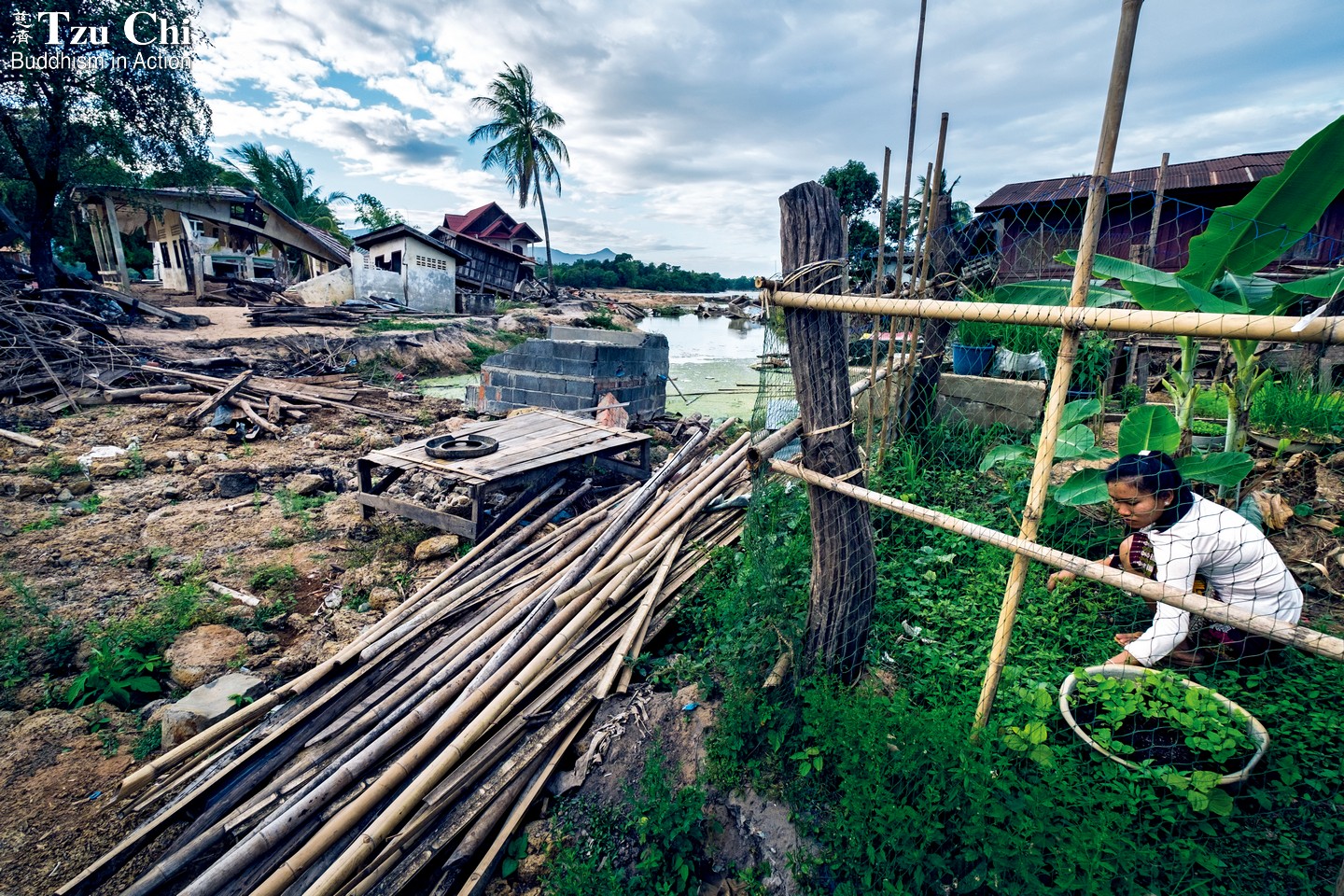
The Granary of Laos Dealt a Hard Blow
A resident of Savannakhet Province tends to her kitchen garden. An important rice-growing district in Laos, Savannakhet was hit hard by flooding in the summer of 2019. Three months after the disaster, houses and schools were still in bad shape. Some areas still had standing water.

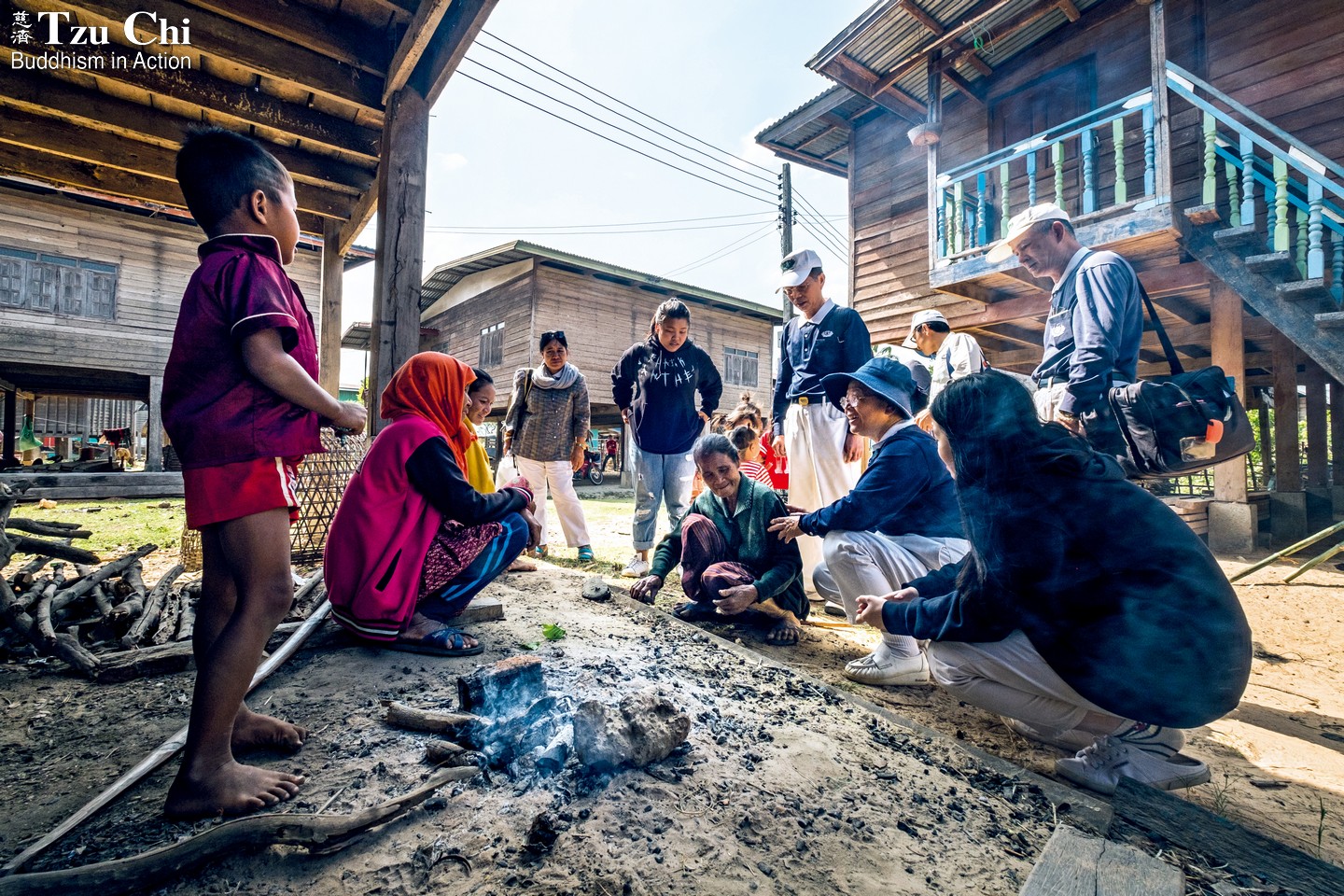
Tzu Chi volunteers, accompanied by Lao government officials, visit flood-affected villagers. The villagers recounted how panicked they had felt when they had to climb onto their roofs to escape the rising floodwaters.
The light of dawn spread upward from the east, lighting up the pale blue sky and waking the birds in the trees. In contrast to this serenity, one small bus after another whizzed by on the uneven country roads, stirring up clouds of yellow dust.
May Kay Sa, from the village of Banla, Champasak Province, southwestern Laos, loaded the tools and ingredients she would need for the day onto her motor scooter and set off to where she would set up her food stall that day. She had decided on the spot two or three weeks before: Sapay Temple, located near a tributary of the Mekong River.
At the same time, a team of Tzu Chi volunteers from Taiwan, Thailand, Malaysia, Laos, Myanmar, Cambodia, and Vietnam had arrived at Sapay Temple. They began methodically setting up the distribution venue. Cooking oil, salt, sugar, and other items that had arrived a few days earlier were being organized to make the distribution efficient. Near the riverbank, a dozen villagers were listening intently to Tzu Chi volunteers explain to them how they were expected to help out during the event. A Tzu Chi distribution was gearing up to start.
The life force of the farmers
May Kay Sa had learned of the distribution beforehand and had intentionally arrived earlier than aid recipients. She began to set up her stall in the shade of some trees just outside the temple. She took out two flat, broom-like bamboo tools, each about 40 centimeters (16 inches) long, and used them to pick up a piece of thin, rolled-out dough. She began toasting the dough over a stove. The dough expanded with the heat to form a large senbei-like Kao Hu Sa, a snack that is made from sticky rice, regular rice, eggs, and sugar.
The sticky rice May Kay Sa used was harvested from her family’s farm the year before. The farm typically yields about a hundred 32-kilogram (70-pound) bags of sticky rice each year after the rainy season. Her family sells some of the rice for income.
However, floods had ravaged southern Laos three months before. Homes, possessions, and farmland were inundated with deep water. May Kay Sa’s five-member family found their finances strained as they lost their rice crops to the deluge. To support themselves, they began running roadside stalls. They went to separate locations each day to set up their stands.
More stalls sprang up around the temple as the sun rose. Like May Kay Sa and her family, many people had turned to different kinds of work after losing their crops to the floods. They needed to earn money to carry them through until the next planting season.
May Kay Sa could usually bring in 100,000 to 120,000 kip (US$11-14) a day when there were large crowds, like those at traditional festivals, but most of the time her income wasn’t very stable. Even though she would be receiving aid the following day at another Tzu Chi distribution, held where she lived, she still came to the temple to take advantage of the opportunity to make money. Anything she could earn would help her family’s income.
Stilt houses submerged
The rainy season in Laos starts in May. During this time, the amount of water in the Mekong River, which flows through several countries including Laos, Myanmar, and Thailand, increases considerably. Most of the time, people get through this period safely, and the rice they plant at this time can produce enough to carry them through the year.
That wasn’t the case in 2019, however. Tropical storm Podul hit Laos in late August, followed closely by tropical depression Kajiki in early September. The massive amounts of rain unleashed by the storms caused the Mekong River to swell and burst its banks. The resulting floods slammed six southern provinces in Laos, affecting as many as 160,000 families.
“The water rushed to us from the Mekong’s tributaries and from all over. It happened so fast it was impossible for us to make it to safety in time,” said Noudee, who was waiting in a line at Sapay Temple to receive her relief goods. Her uneasiness was obvious, revealed by her tightly clenched hands, as she recalled the flooding. The floodwaters destroyed large expanses of farmland that had been sown with rice over two months before. Even the stilt houses which most people in the countryside inhabited and which stood at an average height of two meters (seven feet) could not escape the ravages of the floods.
Continuous downpours prolonged the flooding. In some areas the water didn’t recede until two weeks later. The area impacted was huge and the devastation was worse than the government had expected. In badly hit regions, more than farmland was destroyed—houses, schools, roads, and bridges were hard-hit too. The situation was so bad it looked like Armageddon.
Some public welfare organizations distributed milk and cookies in the immediate aftermath of the disaster so that people wouldn’t go hungry. The Lao government’s agricultural sector also distributed three days’ worth of rice in some disaster areas. However, this aid could only last a short time. Ninety percent of the country’s population rely on farming for a living, with rice being the major crop. With vast swathes of rice paddies ruined, farmers lost not only their crops but the rice seeds that would be used for next year’s planting. Their lives were plunged into distress.
Lao government officials wrote to Tzu Chi and asked for help. In response, volunteers twice visited the disaster areas to assess the extent of devastation. After careful evaluation, 123 volunteers from six countries arrived in Laos in late November to conduct distributions for flood victims in Sonnabouly, Savannakhet Province, and Sanasomboun, Champasak Province. Among the distributed items were rice, cooking oil, salt, sugar, and the most important source of income for local farmers: rice seeds.
Tzu Chi volunteers, local helpers, and relief supplies travel on a tributary of the Mekong to a disaster area.
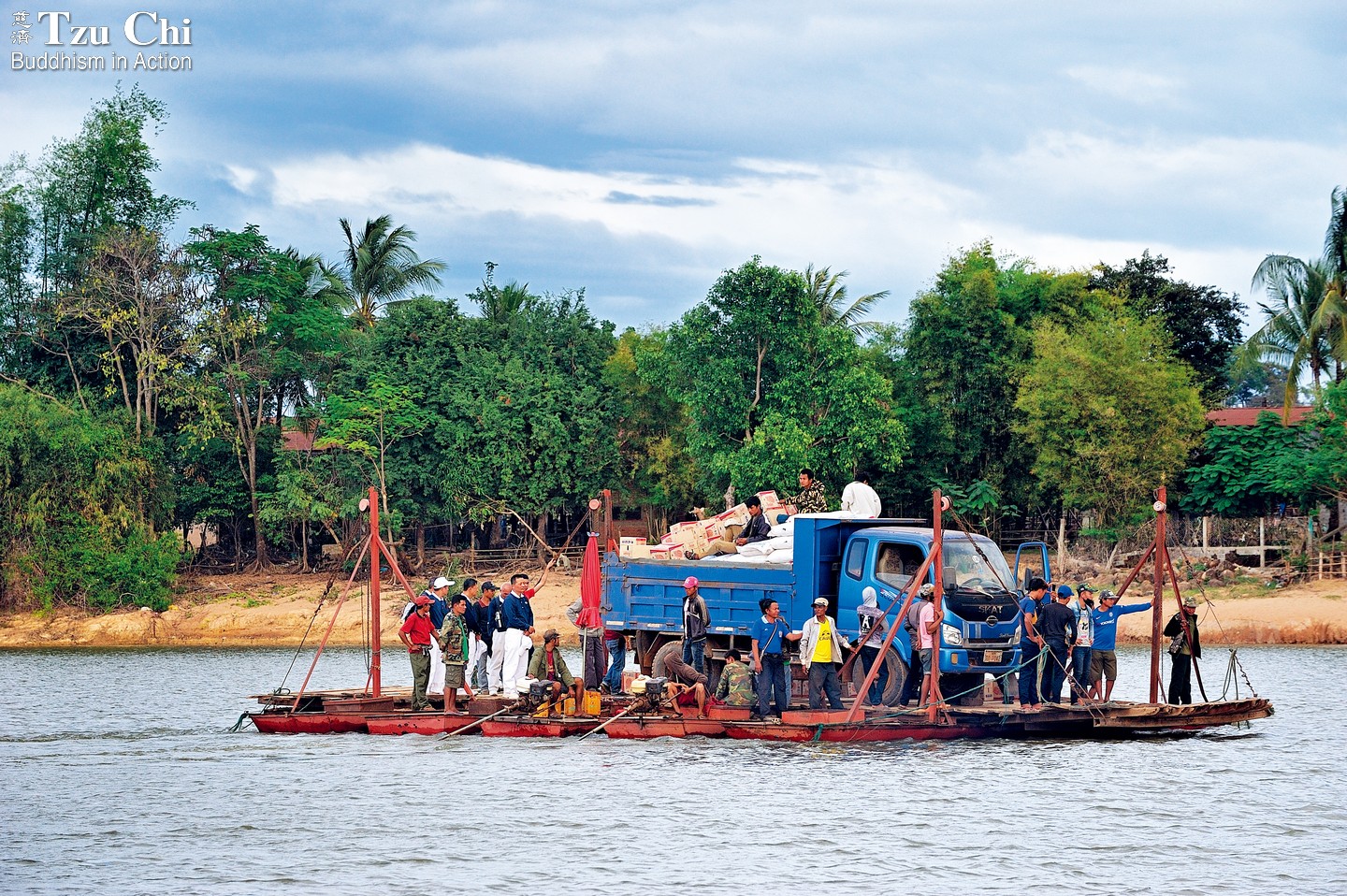
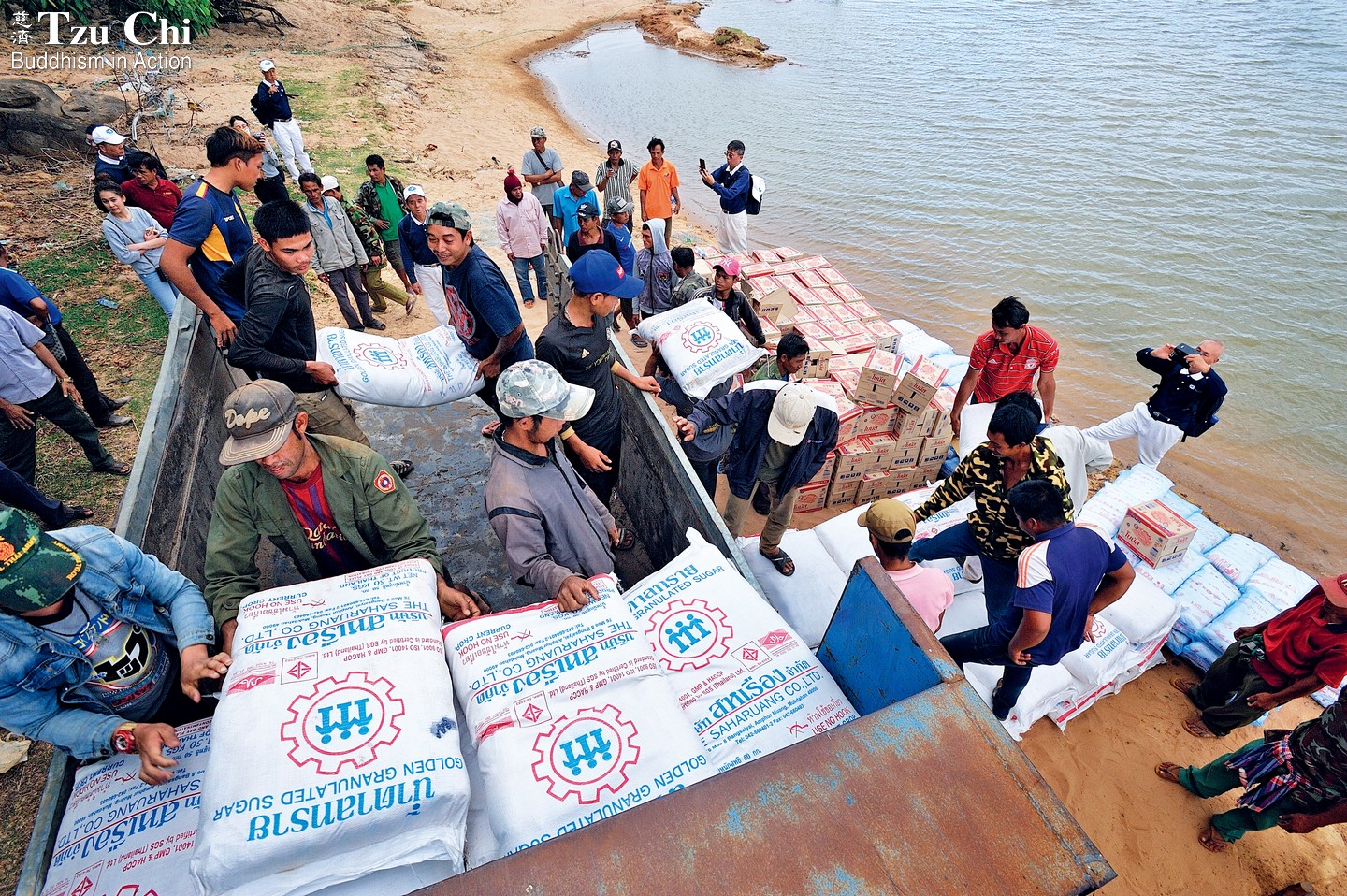
Local young people load Tzu Chi relief goods onto a truck to be transported to a distribution venue in Champasak Province.
Difficult road conditions
Before the distributions could take place, the Tzu Chi Foundation had to first process a lot of paperwork with the Lao government. After that was done, volunteers immediately began to look for quality rice seeds in Laos to distribute. They needed 600 metric tons (660 tons) to aid 10,000 farming households. With help from Hong Zai-sheng (洪再生), a Taiwanese rice expert, and after discussions with local rice seed merchants, agriculture officials, and rice seed center staff, Tzu Chi settled on Thasano 11, a much sought-after variety of sticky rice seed in Laos.
There were ten distribution venues, spread across the plains and hills in the two provinces of Savannakhet and Champasak. Due to inadequate infrastructure and road construction in the country, volunteers experienced very bumpy roads on their way to the venues. One time, their vehicle even got stuck in a pothole. Another time, volunteers had to cross an undeveloped, protected forest area in four-wheel drive vehicles to reach the venue. Only a small number of volunteers went to that location to put aid in the hands of villagers.
Though it was difficult to transport people from place to place, it was an even greater challenge to move the bulk of goods from one place to another. When the large trucks carrying supplies came to bridges with lower load capacities, everything had to be unloaded into smaller trucks. Spreading the weight of the goods out among smaller vehicles was the only way they could be transported across the waterways.
Instead of being disheartened by the difficulties, volunteers became even more determined to safely deliver Tzu Chi’s aid to flood victims. They sincerely hoped that the aid, made possible by the kindness of people from all over, could help dispel the post-disaster gloom for those affected.
Chen Zheng-hui (陳正輝), an entrepreneur in Laos, had helped Tzu Chi carry out relief work after a dam collapse in the nation in 2018. In the aftermath of the flooding this time, a car repair shop he owned was used by the government as a temporary shelter for survivors. The shop later served as a hot food station and a Tzu Chi disaster relief service center. For months after the floods, Chen helped Tzu Chi organize aid for the survivors. From assessing damage in the disaster areas to getting relief goods ready, he was there to help volunteers overcome all kinds of difficulties.
“Some difficulties were obvious,” Chen said. “They were like the leaves and flowers on a tree, in plain sight. But the obvious difficulties weren’t the main challenges. The truly thorny challenges were like the roots of a tree. They couldn’t be easily detected.” However, no matter how difficult a problem was, he faced it humbly and positively, upholding the Tzu Chi principle of “gratitude, respect, and love.” His positive mindset kept things in perspective for him.
Chen Zheng-hui (first from left), an entrepreneur in Laos, did his utmost to help Tzu Chi carry out relief work for flood victims. He was there every step of the way, from assessing damage in disaster areas, to choosing relief items and inquiring of their prices, to helping conduct distributions.
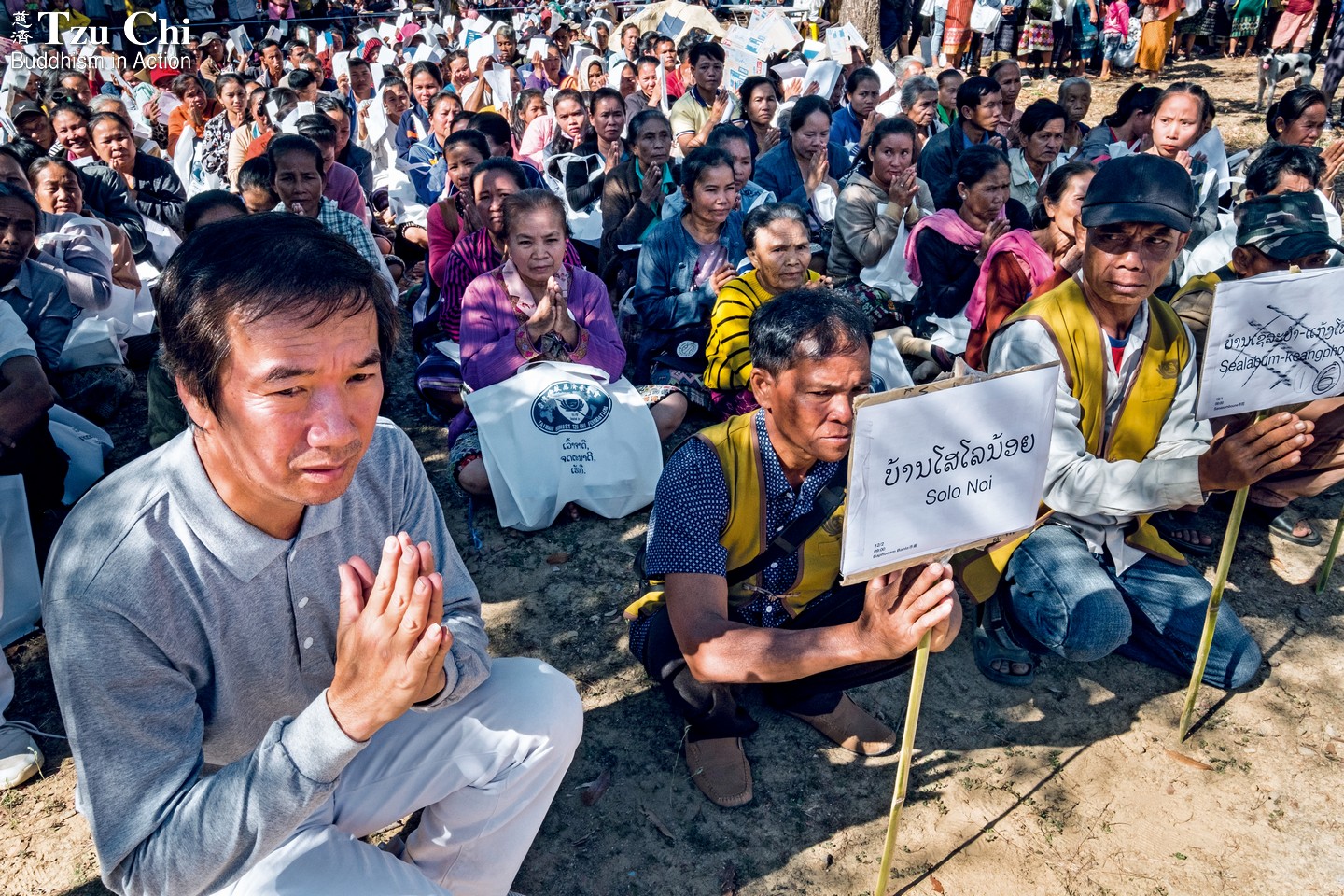
Like a family
“Sabaidi!” Volunteers, every one of them smiling, greeted the aid recipients who had arrived at the distribution venue at Sapay Temple with the Lao version of “hello.” Their warmth and enthusiasm instantly shortened the psychological distance between them and the villagers.
With the aid of an interpreter, a volunteer who was serving as an emcee for the event at the temple square told the crowd, “We are Tzu Chi from Taiwan.” She explained to the villagers the proceedings of the distribution ceremony, and then guided them to pray in Chinese that the rice seeds distributed would lead to bumper harvests. In awkward Chinese, the villagers said again and again, “Bumper harvests, bumper harvests….” The fervent wishes and blessings from Tzu Chi volunteers resonated through the square.
This was the first time most of the locals had participated in such a large, impressive distribution. Fifty-four-year-old May Kun Sai didn’t leave immediately after she had received her relief supplies but stayed to take in more of the event. “This is the first time I’ve taken part in a distribution,” she said. “It feels very special.”
Recalling the time of the floods, she said that the water was almost higher than her head when the flooding was at its worst. She was fortunately able to evacuate in time, but the rice seeds she had in storage were ruined by the water. There weren’t many odd jobs to do in the countryside, so after the disaster she relied on a meager allowance her daughter sent to her. Her daughter had moved to Thailand after she married a man there. “I’m really so grateful for your help,” May Kun Sai exclaimed. The aid from Tzu Chi would temporarily resolve the difficulties she was facing after the floods.
Laos is just one river away from Thailand, and the two nations share many linguistic and cultural similarities. Most Laotians can speak and understand Thai. Thus, when the Thai version of the Tzu Chi song, “One Family,” was played at the venue, May Kun Sai listened carefully. She felt that this group of foreigners clad in blue shirts and white trousers conveyed the warmth and care of a family.
The warm feelings were mutual. Volunteers were touched by the villagers’ responses when they shared Tzu Chi’s origin with them and encouraged them to give what they could to help others. When the villagers learned that Tzu Chi had started with 30 housewives each saving a little of their grocery money every day in a bamboo coin bank to help the needy, they enthusiastically deposited what money they could spare into the coin banks held out by volunteers. This was heartwarming, considering that they had just lost a lot to the floods. In five days, volunteers collected 14,000,000 kip (US$1,576) during the distributions.
The villagers who had no money to spare were also able to demonstrate their love, by placing their hand on their heart and then making a gesture of depositing money into the banks. “One by one, they put their love into the bank. That’s so touching,” said volunteer Pan Xiao-tong (潘曉彤), from Cambodia. At first, she didn’t understand why the aid recipients were putting their empty hands on the coin banks, but after she realized what the action symbolized, she was profoundly moved, her heart full of gratitude for their heartwarming gesture.
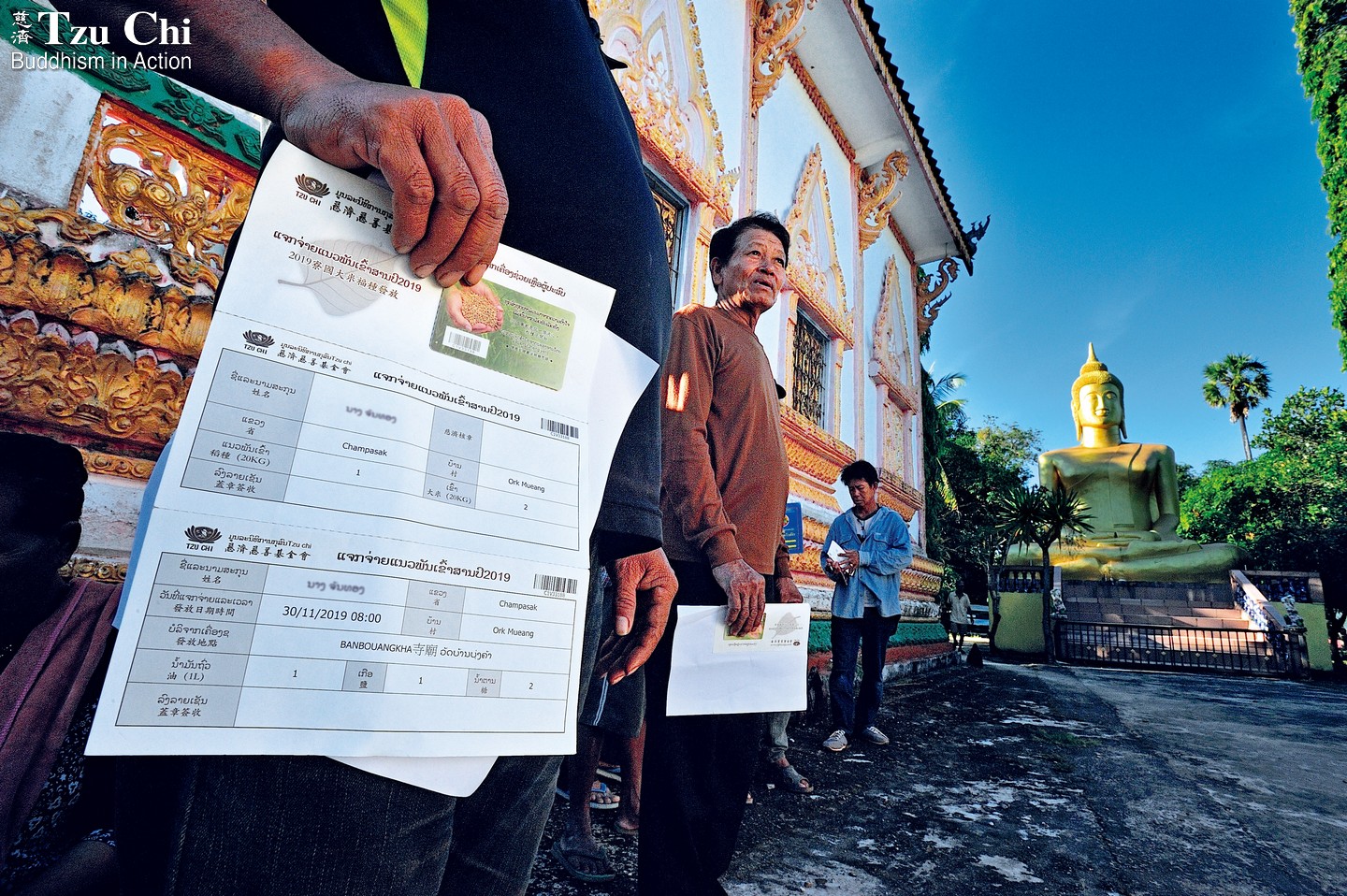
Villagers who have arrived early at a distribution venue clutch claim checks in their hands.
Working together to help farmers
Tzu Chi’s distributions were held over five days. The delegation broke into two groups, each handling different distributions. The largest event served 2,500 recipient families. All told, 15 distributions benefited 55,000 people.
Given the large number of families receiving aid from Tzu Chi, efficiency was of the essence. The foundation used an on-line database system this time to build up data on the recipient families. When villagers reported to a distribution, volunteers didn’t need to sort through paper rosters to find information about them. Instead, volunteers used a cell phone to scan a claim check a villager had received beforehand to confirm their identification. This greatly shortened the processing time.
Villagers received cooking oil, sugar, and salt at the distributions. As for the rice and rice seeds, recipients were required to come back to the venues at the times and dates assigned by the local government to obtain their share.
As the distribution of household goods was underway, the agriculture departments of the Champasak and Savannakhet provincial governments were busy preparing the rice seeds that Tzu Chi would distribute to farmers. In a processing factory, workers first manually sorted through seeds before dumping them into machines to remove unwanted objects, such as straw and dry stalks. Then the seeds were put through hullers before they were packed into sacks of 20 kilograms (44 pounds) each to be transported to different distribution venues. A lot of work was involved before the aid could be put into the hands of the recipient farmers.
Every distribution involves different people and is held at different times and places, so they all present different challenges to volunteers. “In Laos, the biggest hurdle was the language barrier,” said Taiwanese volunteer Hong Qing-xia (洪清夏), who had worked on the relief mission to Laos from the very beginning. He was on the reconnaissance team who had visited Laos in September and now was back in the country helping with the distributions. He explained that though students from a local overseas Chinese school served as interpreters at the venues, there weren’t enough of them to go around. As a result, volunteers had to resort to hand gestures or body language to get their messages across.
Though the language barrier might have made their work more difficult, volunteers were very happy to be of service to the flood-affected farmers. By delivering aid to them, volunteers hoped more than anything else that the farmers could feel the warmth and love of this world; they hoped to help them know that people cared, even though unrelated and unbound by blood ties.
Laos is the only landlocked nation in Southeast Asia. It has always seemed shrouded in a veil of mystery, due to its unique geographical location and conservative social ambience. Without personally visiting the country, it’s hard to appreciate the simple, down-to-earth charm of its rural villages and people. Perhaps because of the influence of centuries of Buddhist belief, most farmers remained optimistic despite the devastation and trauma left behind by the floods. It’s everyone’s sincerest hope that the rice seeds from Tzu Chi will bring them bountiful harvests and big smiles.
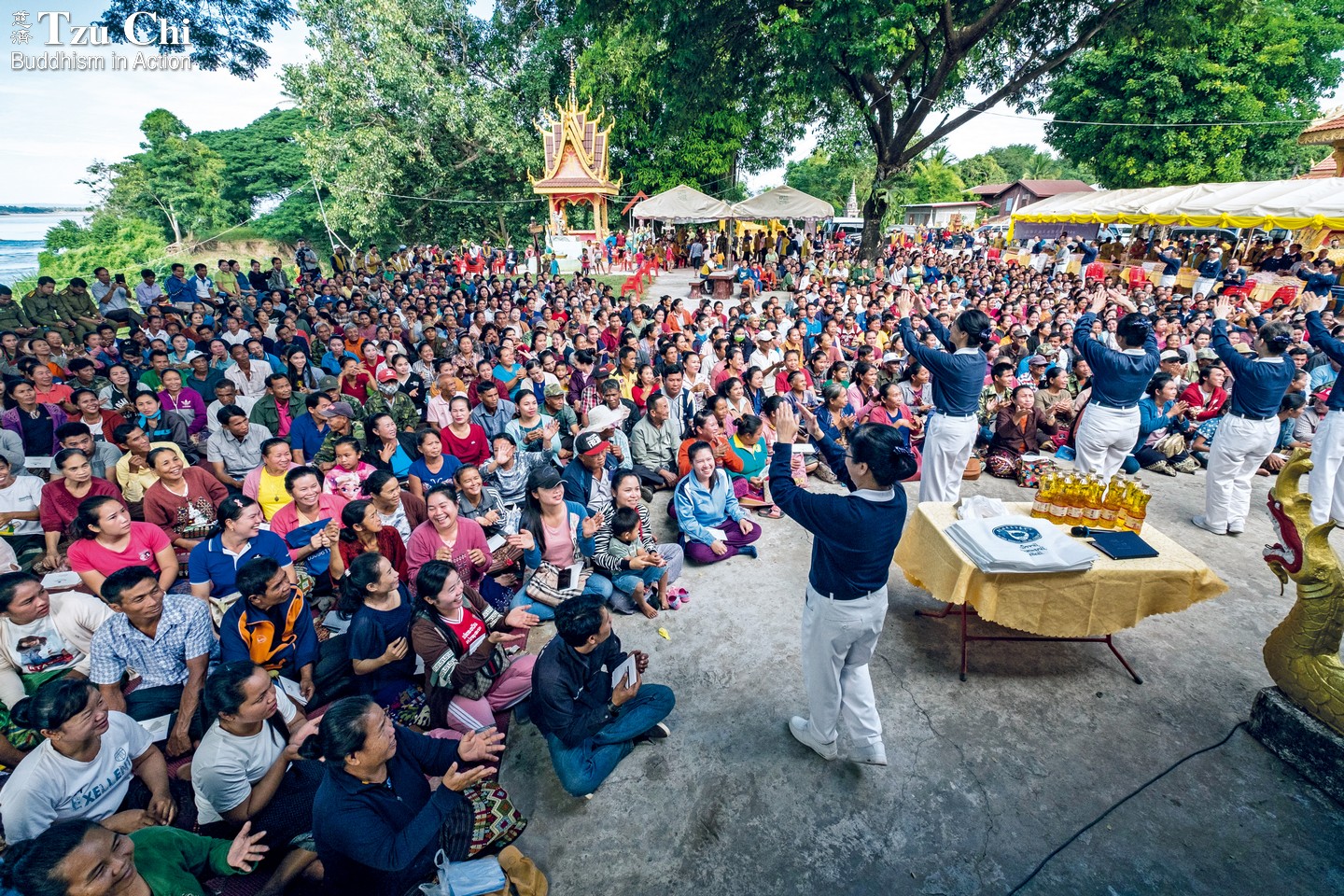
Tzu Chi volunteers perform the song, “One Family,” with accompanying hand gestures at a distribution held at Sapay Temple, located near a tributary of the Mekong River. More than 2,000 families from eight villages benefited from this distribution.
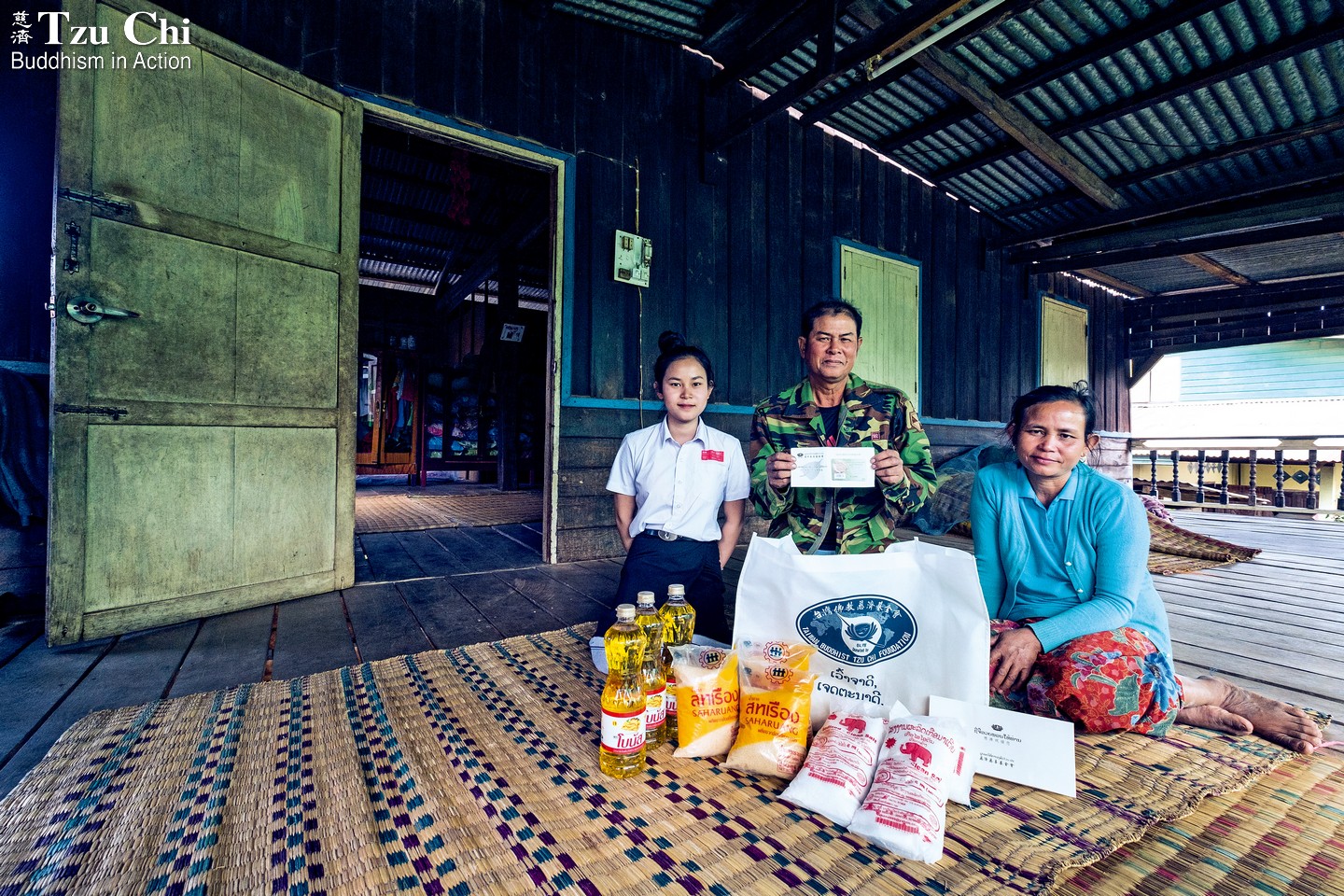
A family poses at their home with the items distributed by Tzu Chi.

